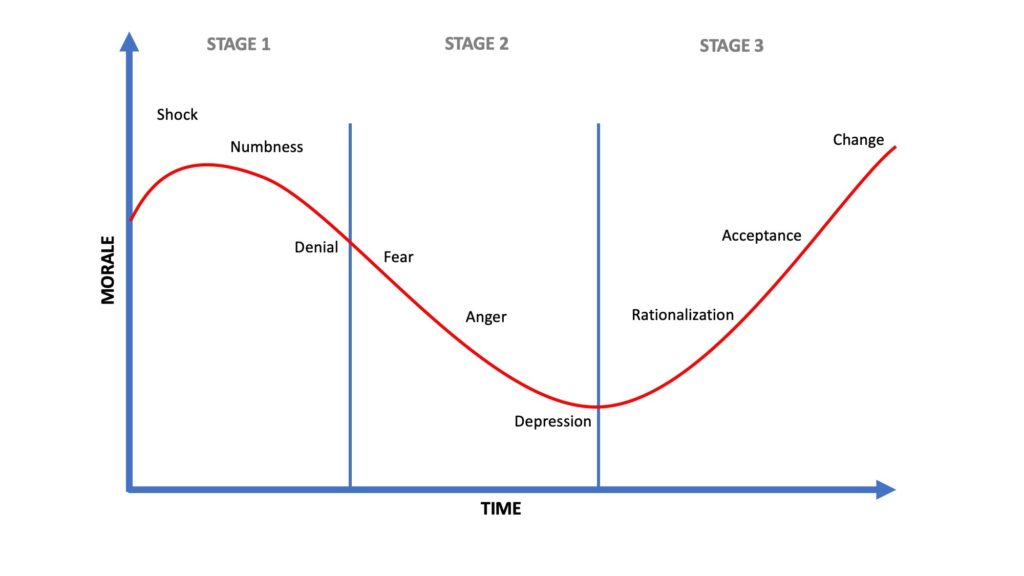Change is hard.
For more than a decade, I’ve used that simple reminder to start every discovery and transformation engagement. Even with that warning in mind, those responsible for leading change in any business will often underestimate just how hard it can be to land meaningful change well. Change is a very personal thing. Only by proper agility planning one can land meaningful change in any business.
In general, people will process change in three stages, beginning with shock before finally accepting the change and moving on.

Though no formula can smooth the change adoption curve, there are things we can do to help people as they move through the stages of acceptance and shorten the amount of time between shock and ‘the new normal.’
- Address the humanness of the system. When introducing change, we are often tempted to focus on the system, the process, or the outcome. We inadvertently marginalize the most critical component to successful change: the people. By placing the people first and doing our best to understand how the change will impact the organization and customers, we can do our best to forecast and mitigate the negative emotions that may emerge. Ask yourself: “What fear may emerge as a result of this change?”
- Start with leadership. Change must be thoughtfully led. Too often, change initiatives fail because a leader will issue a directive and then check out. Change needs a champion, and the broader the impact, the stronger advocate that change will need. When leading change, it’s best to be visible, be consistent, empathize with the current, and maintain focus on the goal.
- Involve everyone. When introducing change, it’s important that those involved do not feel that there are two sides: those impacted (us) and those imposing (them). Again, change leaders need to create an environment that is empathetic to the pain of change (all of us, together) and keeps those involved focused on the outcome resulting from having changed.
- Create a compelling business case. Start with why. Why is this change important? What risk is it mitigating? What opportunity is it enabling? What efficiency will we be able to exploit? How will we be better positioned to serve our customers? John Kotter notes that we underestimate the power of vision by a factor of 10. That perspective proves true no matter the size of change. Without understanding why the pain we are about to endure is worth it, change is harder to overcome.
- Create shared ownership. Change in an organization or value stream is not something to be done in isolation. If the change is beholden to a single person or small group, it will matter much less to others and quality will suffer. Change outcomes are a shared responsibility of the team. Creating an all-of-us-together culture helps avoid feelings of pain endured in isolation.
- Communicate the message. Communicate the message early, communicate it consistently, and communicate it often. In alignment with the SAFe® Core Values, we must assure alignment and transparency in the system to achieve optimal outcomes.
- Assess the cultural landscape. Even if we prepare the organization well for change, even if we say and do all of the right things, organizational culture will dictate how well people in the system process change. I am often reminded of the wise words of Kim Scott: “Culture is what is said in the halls, not what is written on the walls.” Employee engagement surveys, rolling feedback walls, and hallway conversations can go far in helping change leaders understand how people are really feeling.
- Address cultural challenges directly. If understanding the cultural landscape is step one, doing something with what you learn is step two. When the pain of change rears its ugly head, change leaders must address this pain immediately and directly. This is not a time for political grandstanding but for using the organization’s own words with a sense of empathy. Remember, as Brené Brown teaches us, being empathetic does not always mean fixing the pain. Simply acknowledging the circumstance and validating how people feel can have a profound impact on morale.
- Prepare for the unknown unknown. As Murphy’s Law reminds us, if something can go wrong, it will. Though there is not a lot we can do to prevent unforeseen circumstances, we can prepare for them. Actively seek risk, break things, pressure test, and create fallback and recovery plans. The SAFe approach to DevOps can serve as a good guide to monitor for and respond to the unknown.
- Speak to team members. The most important component in addressing the human element of change is to talk to the people involved. Be visible, be accessible, and be the kind of leader that people trust. When leading change, if you can successfully manage the emotional component, you are well on your way to helping the team land change well.
The next challenge? Avoid change saturation to land change well. Stay tuned!
About Adam Mattis

Adam Mattis is a SAFe Program Consultant Trainer (SPCT) at Scaled Agile with many years of experience overseeing SAFe implementations across a wide range of industries. He’s also an experienced transformation architect, engaging speaker, energetic trainer, and a regular contributor to the broader Lean-Agile and educational communities. Learn more about Adam at adammattis.com.
Share:
Back to: All Blog Posts
Next: POs and PMs: A Dynamic Duo